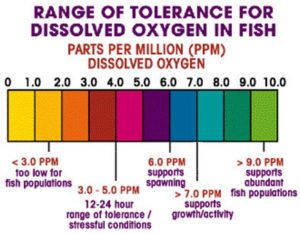Life in an aquatic environment is quite different from life on land. Although life first evolved in the seas and then colonized land, the challenges for survival and growth cause distinct growth patterns.
Water
- In aquatic environments, water is always present as long as the habitat remains intact.
- On land, water cannot be taken for granted. Droughts can limit survival, and areas with frequent floods require special adaptation from the plants and animals that live there.
Temperature
- Temperatures in water change slowly and over a smaller range in a given period. In winter, when ice covers a lake, water will remain above freezing under the ice. In the summer, the water temperatures will warm slowly, but it won’t get as warm as the daily high air temperatures. On any given day, the water temperature range is less than the temperature change in air.
- On land, the daily temperature range can be very large and the seasonal changes as well as daily temperature cycles are more volatile and variable than in water.
- For ectotherms like amphibians, turtles, and insects, where the body’s heat comes from outside, temperatures in the water provide a more constant and predictable body temperature, generally requiring less adaptation.
Light
- Light is a precious commodity in lakes. Sunlight is absorbed quickly in water, transferring heat. Even at relatively shallow depths there might not be enough light for plants to grow. Some light is also reflected back at the water surface. In addition, both plants and algae can limit light getting into the water column. The deep parts of our lakes are dark and cold.
- The atmosphere doesn’t result in a light gradient for terrestrial plants and animals, although plants can compete for light, resulting in some shade specialists.
Oxygen
- In the best case, dissolved oxygen in water is only about 1/20 of the amount of oxygen available in the atmosphere, so oxygen availability is a concern for life in lakes. The amount of oxygen that water can hold decreases as the water temperature increases. Biological activities can affect the oxygen content in water. Plants pump a lot of oxygen into the water during daytime photosynthesis activities, but at night they respire, or use oxygen and produce carbon dioxide just like animals. In environments with a lot of plants and algae, the water can go hypoxic or to low oxygen levels. In the deep waters of lakes where light doesn’t reach, it is common to have anoxic water, or water without any oxygen. This can make survival tough for creatures.
- Oxygen is always abundant for terrestrial animals because it’s abundant in the atmosphere, and the atmosphere is well-mixed.
Buoyancy
- Water is denser than air, and its buoyancy helps counteract gravity. Aquatic plants don’t have woody tissues but often have air spaces (aerenchyma) for buoyancy. Currents can help circulate plankton to sunlit upper waters. Viscosity can be an issue for small aquatic life since water will “stick” to their surfaces, making coasting impossible. Large animals encounter much less drag – about what humans experience while swimming.
- Terrestrial plants and animals have to expend energy building woody structures that can resist gravity. However, viscosity is not an issue and the friction from moving through air is reduced.